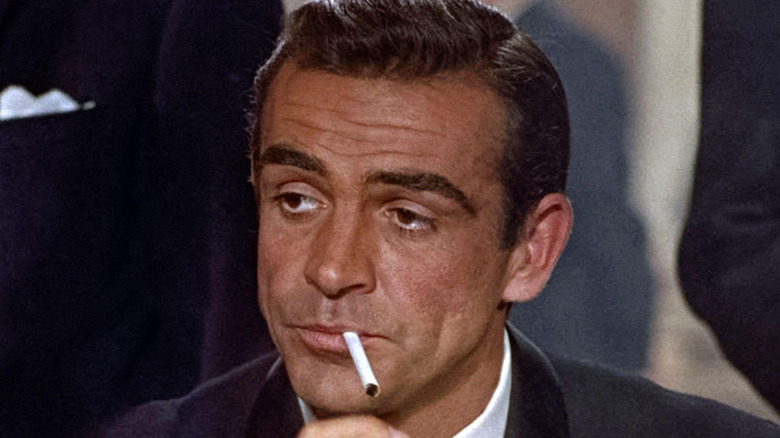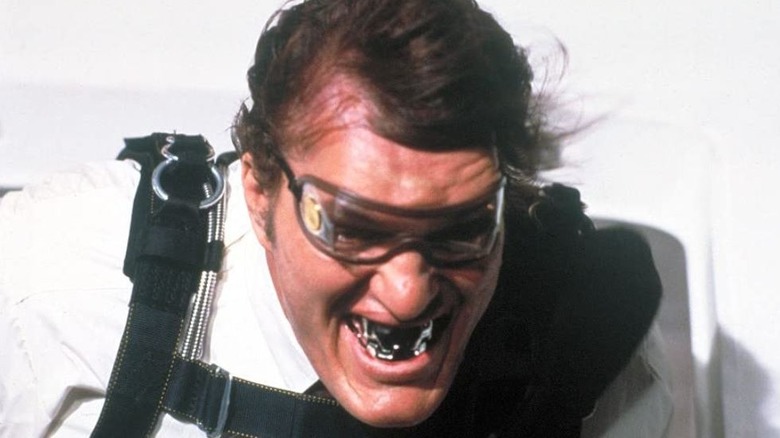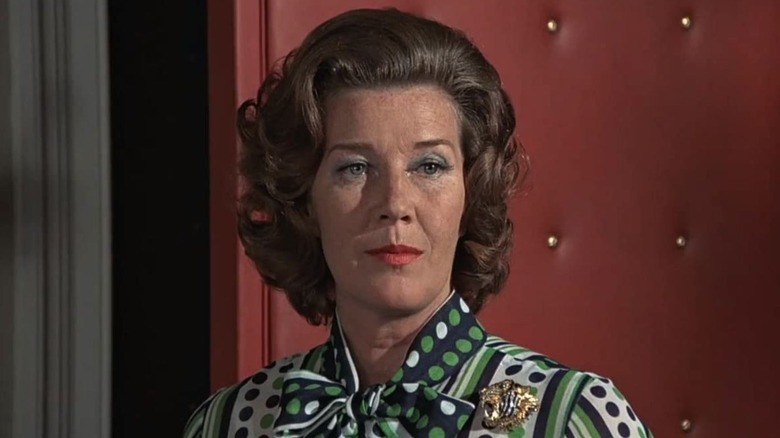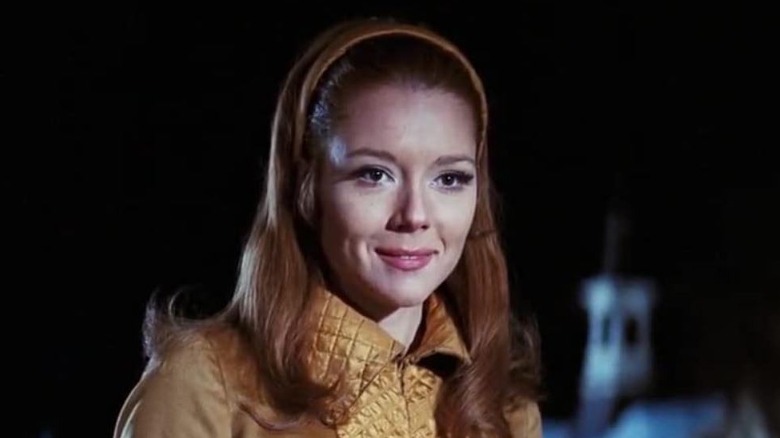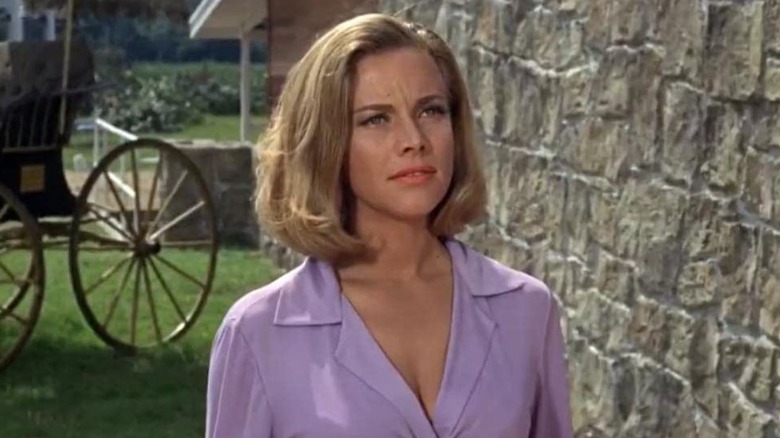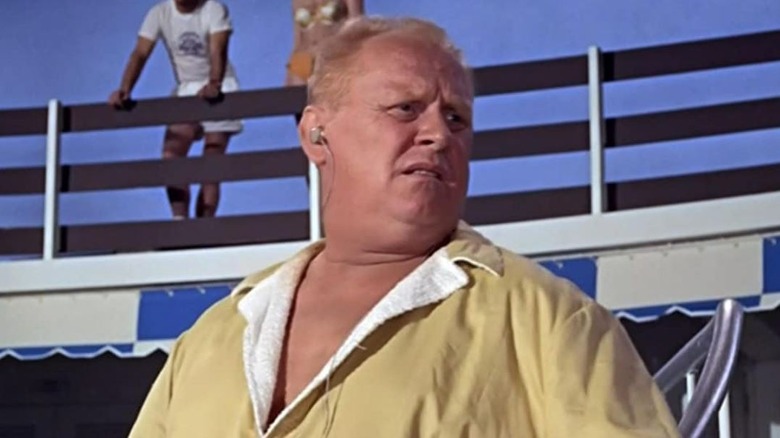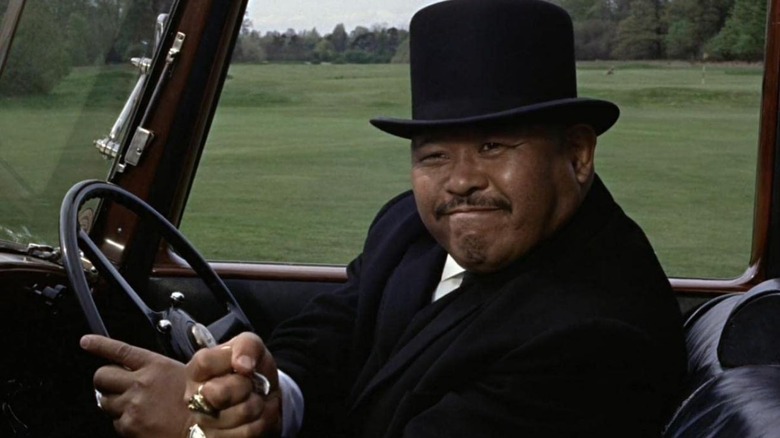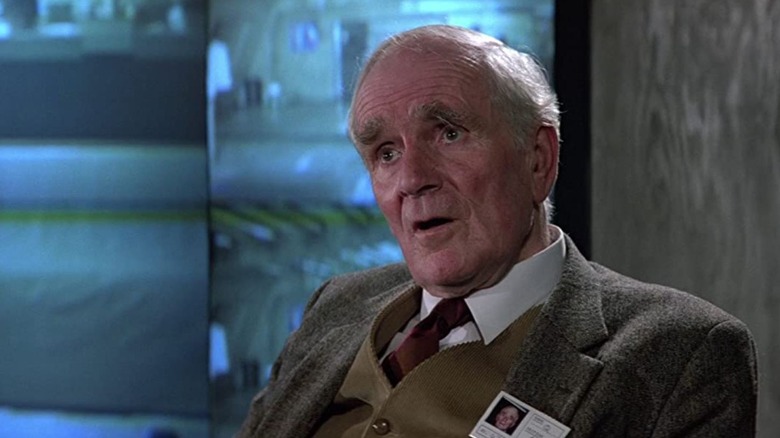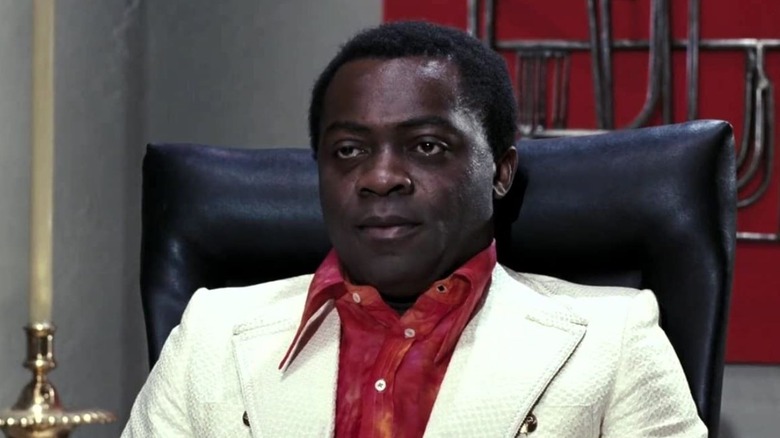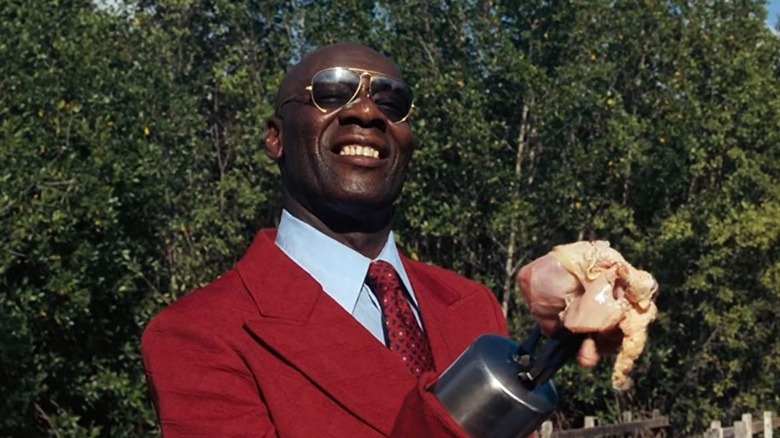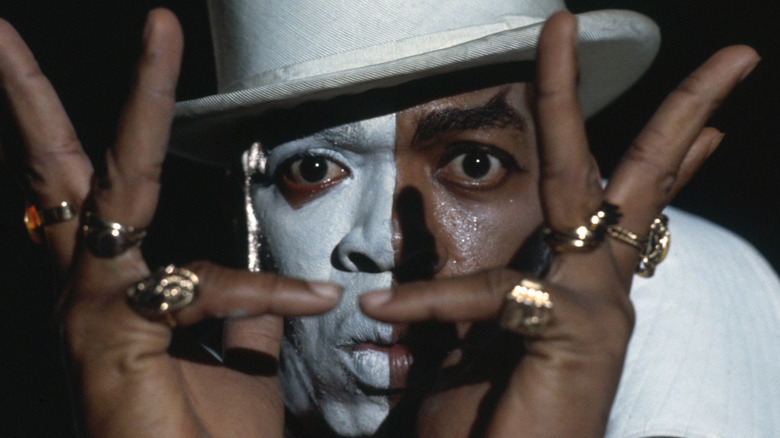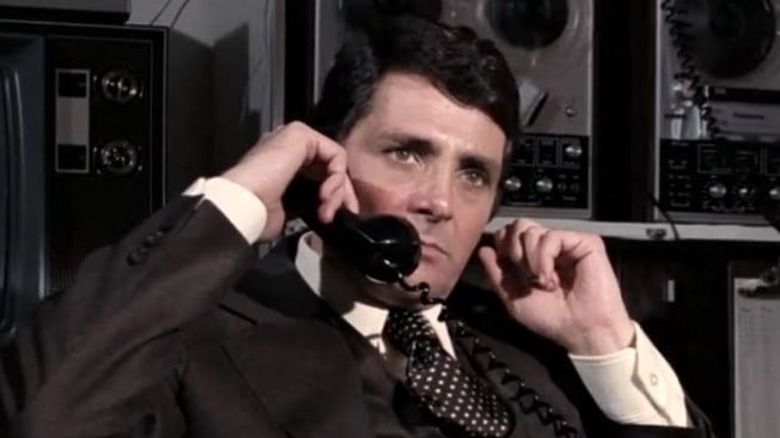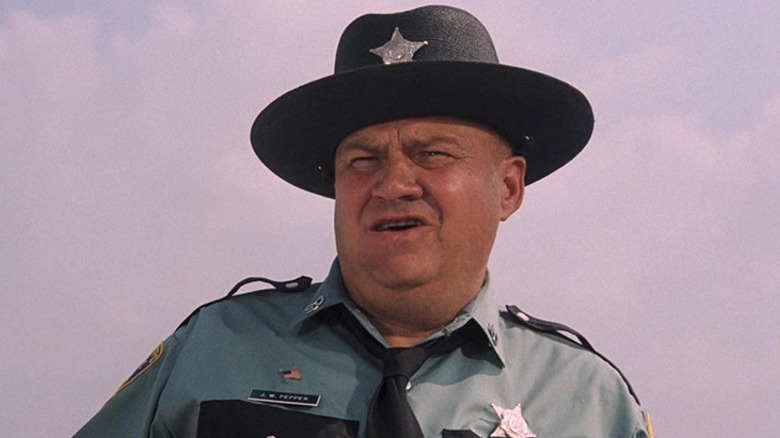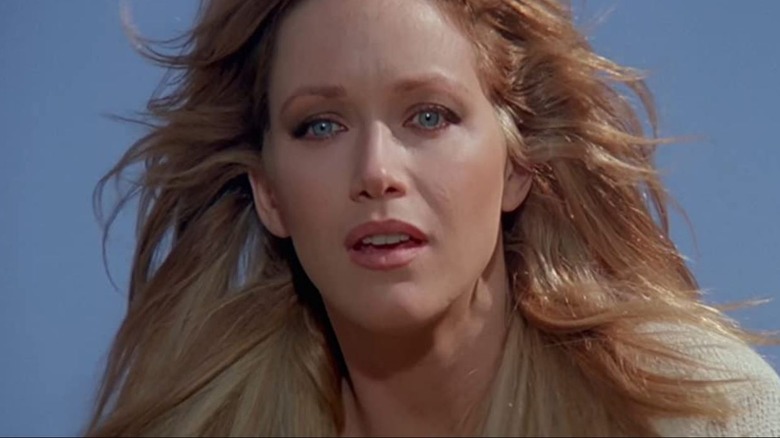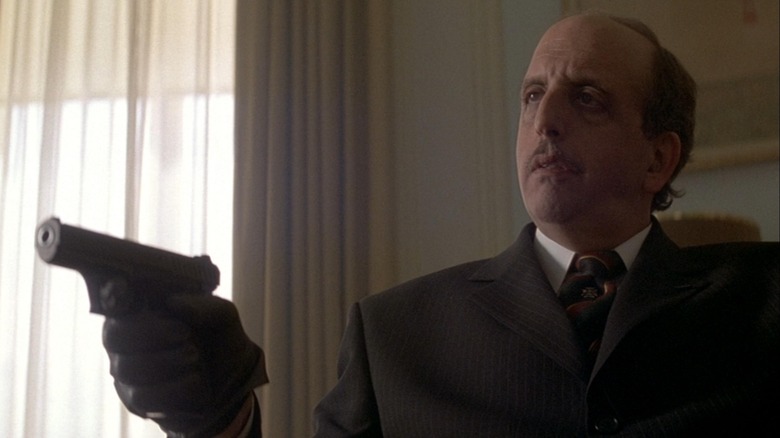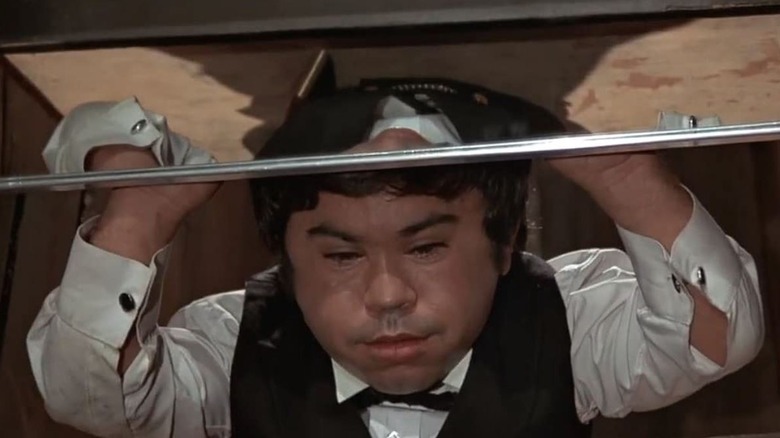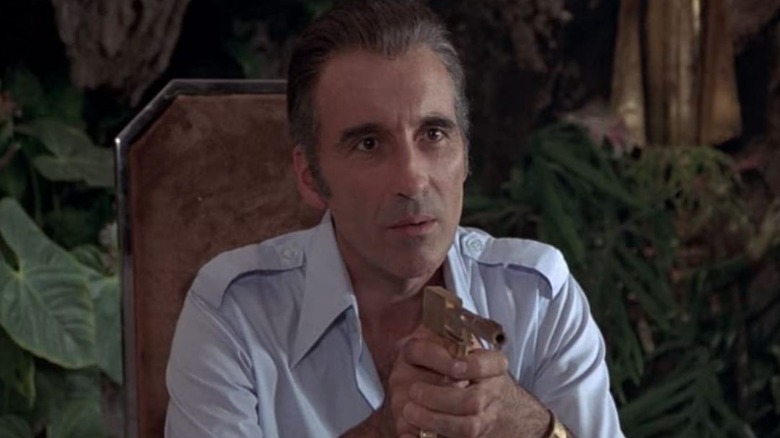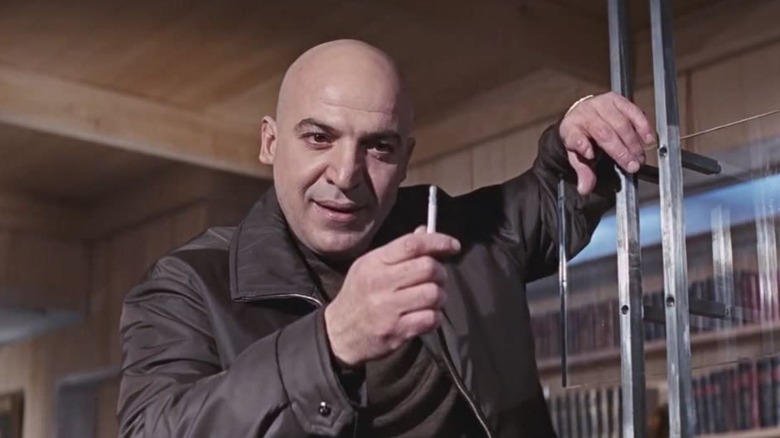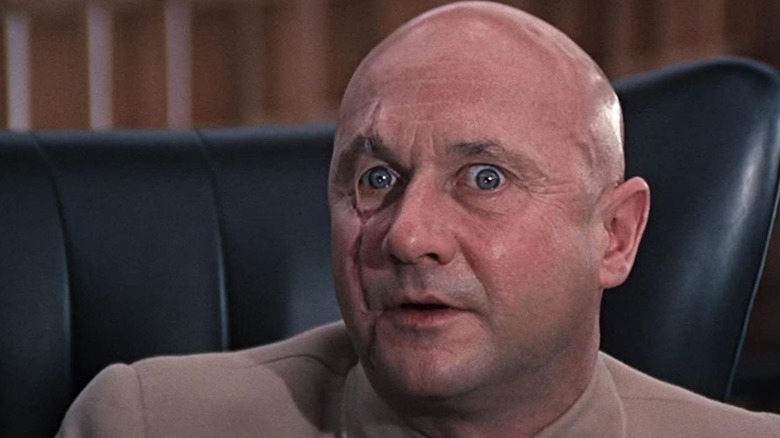James Bond Actors You May Not Have Known Passed Away
Without question, Eon Productions' James Bond film series has been one of the most successful franchises in cinematic history, with 25 films produced to date, including the upcoming, long-delayed "No Time to Die." The series kicked off, of course, with "Dr. No" in 1962, with Sean Connery playing the dashing British secret agent who goes by the code name 007. Over the years the Bond mantle has been taken up by five other actors: George Lazenby, Roger Moore, Timothy Dalton, Pierce Brosnan and Daniel Craig.
Sadly, Roger Moore — who starred in seven Bond films — was the first actor who played 007 to die, as he passed away from liver cancer on May 23, 2017, at age 89. Connery, who also played Bond in seven films — six produced by Eon plus the unofficial entry "Never Say Never Again" — became the second actor who played the legendary role to pass away, as he died from pneumonia and heart failure on October 31, 2020, at age 90.
While Moore's and Connery's deaths were widely reported, fans may not know that several actors in key lead and supporting roles have died as well. Here's a look at some of the James Bond actors you may not know have passed away.
Richard Kiel's Jaws is one of the series's most memorable henchmen
Standing at an imposing 7 feet, 2 inches, Richard Kiel made a huge impression in Hollywood in the 1960s and early '70s in several television series, including "The Twilight Zone" (as Kanamit, the cookbook-holding alien giant in the classic episode "To Serve Man"), as well as other hits including "Wild, Wild West," "I Dream of Jeannie," "The Monkees," and "Kolchak: The Night Stalker." Kiel also made his mark in films, alongside Burt Reynolds in the prison football comedy "The Longest Yard" and opposite Gene Wilder and Richard Pryor in the crime comedy "Silver Streak."
But it wasn't until 1976 when Kiel secured his place in movie history as Jaws, villain Karl Stromberg's (Curt Jurgens) steely-toothed henchman in Roger Moore's "The Spy Who Loved Me." The character proved to be so popular as James Bond's nemesis that while Stromberg met his demise, Jaws somehow survived and surfaced again in Moore's 007 space adventure "Moonraker" in 1979.
Kiel worked steadily in film and television after his second and last Bond film, turning up in TV guest spots in such series as "The Fall Guy" and "Simon & Simon," and memorable supporting roles in Clint Eastwood's hit Western "Pale Rider" and Adam Sandler's smash golf comedy "Happy Gilmore." The actor's last film came in 2010 with a voice role in the Disney animated hit "Tangled." Kiel died of a possible heart attack on September 10, 2014, at age 74.
Lois Maxwell played Miss Moneypenny in 14 Bond films
While some actors have been lucky enough to enjoy more than one stint as a supporting player in the James Bond film saga, there have been others, especially at the beginning of the franchise, who had perennial gigs. One such actor was Lois Maxwell, who played Miss Moneypenny, the secretary to 007's boss M, the head of the British Secret Service.
Maxwell held the mantle of Moneypenny for 14 James Bond films over 23 years. Beginning with Sean Connery's "Dr. No" in 1962, Maxwell ended her run in 1985's "A View to a Kill," which also marked Roger Moore's final turn as Bond. After that, Maxwell was replaced by Caroline Bliss for Timothy Dalton's two Bond films.
While Maxwell compiled an impressive 80 credits in film and television prior to her exit as Moneypenny in "A View to a Kill," she only worked sparingly after her Bond swan song. She spread out seven film and television projects in the last 16 years of her career, which ended with the 2001 action thriller "The Fourth Angel" opposite Jeremy Irons and Forest Whitaker. Maxwell died of cancer on September 29, 2007, at age 80.
Diana Rigg played the only woman to marry James Bond
In James Bond's illustrious history, the famed secret agent has amazingly only been married once, which happened during George Lazenby's only turn as Bond in 1969's "On Her Majesty's Secret Service."
Diana Rigg played Tracy Bond (aka Countess Teresa di Vicenzo) in the film, which came on the heels of her four-year run as Emma Peel in the classic British spy series "The Avengers" from 1965 to 1968. Unfortunately, Rigg's role as 007's wife began and ended with "On Her Majesty's Secret Service" as she was shot by villain Ernst Blofeld's (Telly Savalas) henchwoman Irma Bunt (Ilse Steppat).
Rigg went on to a prolific career, mostly in television, in the wake of her only Bond film, including the sitcom "Diana" and an Emmy-winning supporting role in the miniseries "Rebecca." Rigg was also revered for her recurring role as Lady Olenna Tyrell in the smash fantasy series "Game of Thrones," earning four Emmy nominations for Outstanding Guest Actress in a Drama Series.
Rigg worked steadily in television until her death at age 82 from lung cancer on September 10, 2020. Most recently, Rigg had a supporting role in the TV drama "Black Narcissus," and she is set to appear in a posthumous role in director Edgar Wright's horror thriller "Last Night in Soho" in October 2021.
Honor Blackman, like Diana Rigg, also starred in The Avengers
Thanks to author Ian Fleming's penchant for naming Bond girls with double entendres, Honor Blackman was bestowed with the suggestive moniker P**** Galore. It's a character name that likely wouldn't pass muster today, even though it originated in Fleming's "Goldfinger" novel.
In the film, Galore is the personal pilot of James Bond's (Sean Connery) nemesis Auric Goldfinger (Gert Fröbe), who is an international gold smuggler. While Galore's fate is unknown at the end of "Goldfinger," Blackman never reprised the role, although the character was brought back — and voiced by actors Jeannie Elias and Natasha Little — in a pair of 007 video games.
Receiving her first screen credit in the 1948 crime drama "Daughter of Darkness," Blackman was well-established in film and television by the time she was cast in "Goldfinger." Just prior to the film, she starred as Hera in the beloved fantasy film "Jason and the Argonauts" in 1963, and played Catherine Gale in the TV spy classic "The Avengers" from 1962 to 1964.
Blackman compiled 114 credits in film and television throughout her career, which included a guest turn as Professor Lasky in "Doctor Who" in 1986, and a supporting role opposite Renee Zellweger in "Bridget Jones's Diary" in 2001. Blackman last appeared in a guest role in the British TV comedy "You, Me & Them" in 2015, and died of natural causes on April 5, 2020, at age 94.
Gert Fröbe was already a star in Germany before Goldfinger
German actor Gert Fröbe brought the villainous Auric Goldfinger to life in Sean Connery's third James Bond film, which took its title from the villain's surname. Starting his film career in Germany in 1948, Fröbe had amassed more than 20 credits in German cinema before he was cast as Goldfinger, an international gold smuggler bent on destroying Fort Knox with an atomic bomb. In the final showdown between Bond and Goldfinger aboard an airplane, Goldfinger is sucked out of the aircraft after he shoots out a window in the cabin.
Even though Fröbe largely returned to German film and television after "Goldfinger," he did occasionally turn up in Hollywood productions, including "Chitty Chitty Bang Bang" and Audrey Hepburn's crime mystery "Bloodline."
Fröbe died of a heart attack on September 5, 1988, at age 75. The actor's last screen appearance came in a posthumous guest role in the German TV series "The Black Forest Clinic" in 1979.
Harold Sakata's Oddjob made a bowler hat a lethal weapon
One of the most memorable strongmen to taunt 007 in the Sean Connery era was Harold Sakata, who played Auric Goldfinger's (Gert Fröbe) henchman in "Goldfinger." The dapper villain not only boasted immense strength, but had the unusually lethal skill of tossing his steel-brimmed bowler hat with deadly accuracy. It was the hat that ultimately led to Oddjob's demise, when Bond purposely wedged it between metal bars. As he tried to retrieve it, Oddjob was electrocuted when Bond pushed a live wire against the bars.
Although Oddjob is described as being of Korean descent in "Goldfinger," Sakata was actually of Japanese-American origin and born in Honolulu. A veteran of the U.S. Army who served in World War II, Sakata's training as a weightlifter led to him earning a silver medal in weightlifting in the light-heavyweight division at the 1948 Olympics.
Assuming the moniker Tosh Togo, Sakata embarked on a 21-year career as a professional wrestler, which lasted from 1949 to 1970. In the early '60s, his work in the ring caught the eye of Bond movie producer Harry Saltzman and director Guy Hamilton, which led to his iconic role as Oddjob in 1964.
Sakata worked steadily after his screen debut in "Goldfinger." He appeared in several guest roles on such hit TV series as "Gilligan's Island," "Quincy, M.E.," "The Rockford Files" and "The Amazing Spider-Man," and also had a recurring role on the TV drama "Sarge." Sakata's last screen role came in 1982 in the horror thriller "Invaders of the Lost Gold." He died of liver cancer on July 29, 1982, at age 62.
Desmond Llewelyn appeared in the most films in the series
As James Bond's quartermaster, Major Boothroyd (simply known as Q), Desmond Llewelyn holds the distinction of reprising his role the most times in the 007 film series. Peter Burton played Q in the first James Bond film, "Dr. No," in 1962, but Llewelyn took it over for 1963's "From Russia with Love" — and reprised the character for 16 more 007 films, ending with 1999's "The World is Not Enough."
Q, of course, was the head of the SIS/MI6's Q Branch, which is responsible for providing Bond all of his technologically advanced weapons, gadgets and vehicles. In the role, Llewelyn was the only actor to work with the first five Bonds: Sean Connery, George Lazenby, Roger Moore, Timothy Dalton, and Pierce Brosnan. There was a brief break for Llewelyn during his 36-year tenure in the Bond universe, however, as the character was absent from "Live and Let Die" in 1973.
With the end of Llewelyn's run as Q evident, "The World is Not Enough" introduced Monty Python legend John Cleese as the quartermaster's assistant, R. In the wake of Llewelyn's death, Cleese's R was promoted to the title of Q for the next Bond film, 2002's "Die Another Day."
Llewelyn died in an auto accident on the way to a book signing event on December 19, 1999, at age 85.
Yaphet Kotto went to space after Live and Let Die
Esteemed actor Yaphet Kotto only appeared in one James Bond movie, but it was a memorable one, especially since it marked the debut of Roger Moore as 007 in "Live and Let Die."
In the film Kotto played Dr. Kananga, the dictator of an island in the Caribbean who masquerades in the guise of Harlem drug lord Mr. Big. Kananga's demise is especially ghastly in "Live and Let Die," as Bond forces the character to ingest a compressed-gas pellet used in shark guns during an underwater fight. After an inflated Kananga emerges from the water and explodes in the air, Bond quips, "He always did have an inflated opinion of himself."
Standing at 6 feet, 3 inches tall, Kotto brought his looming presence to more than 90 films and television shows in his career. Among his best-known roles were Parker, a member of the ill-fated crew of the Nostromo in "Alien," and FBI Agent Alonzo Mosley, who doggedly chases after a bounty hunter and his fugitive (Robert De Niro and Charles Grodin, respectively), in "Midnight Run." Among Kotto's television roles was Baltimore Police Department Shift Lt. Al Giardello for all seven seasons of the hit crime series "Homicide: Life on the Street."
Kotto's last acting credit came in 2014, when he reprised his "Alien" role, in voice only, for the video game "Alien: Isolation." Kotto died at age 81 on March 15, 2021. His cause of death was not revealed.
Julius Harris was a WWII Army medic before acting
Yaphet Kotto's Dr. Kananga/Mr. Big wasn't the only bad guy to menace James Bond in "Live and Let Die" — Julius Harris played Kananga's main henchman, Tee Hee Johnson, who had a prosthetic arm with a pincer grasp. Like Kananga, Tee Hee didn't survive "Live and Let Die," but he perished in a less-gory fashion as Bond tossed him out the window of a moving train, leaving the arm behind.
After serving as an Army medic in World War II, Harris moved on to a prolific career in film and television. Onscreen, Harris' career trajectory was remarkably similar to Kotto's, as he amassed more than 90 screen credits. His big screen work included the blaxploitation classics "Black Caesar" and "Hell Up in Harlem" (both 1973), "King Kong" (1976) and "Looking for Mr. Goodbar," while on TV he appeared in dozens of guest roles on shows like "Kojak," "Vega$," "Good Times," "The Incredible Hulk" and "Friday the 13th: The Series."
Harris' last screen appearance came in 1997 with a guest role on the hit medical drama "ER." Harris died of heart failure on October 17, 1984, at age 81.
Live and Let Die star Geoffrey Holder was also a cool soft drink spokesman
Julius Harris's Tee Hee Johnson wasn't the only notable henchman for Dr. Kananga/Mr. Big in "Live and Let Die" — Geoffrey Holder also made his mark as Baron Samedi, a master of Voodoo. After Bond tosses Tee Hee from the moving train in the film, Samedi is shown sitting on the front of the locomotive in his Voodoo makeup and top hat, laughing villainously in his deep voice as the end credits appear.
Already an established stage actor and dancer before his career in film and television, Holder's screen credits after "Live and Let Die" included the film version of the hit Broadway musical "Annie," opposite Albert Finney, Carol Burnett, and Tim Curry, plus "Boomerang" which starred Eddie Murphy and Halle Berry. Holder was also the narrator for director Tim Burton's adaptation of "Charlie and the Chocolate Factory," although Oompa Loompa actor Deep Roy led the audience to believe it was his voice narrating the film in the final scene.
In addition to his voice role as Ray the Sun in the hit children's television series "Beat in the Big Blue House," Holder put his pipes to work as an enormously successful TV pitchman. He most notably appeared in 7-Up commercials in the 1970s and '80s, where he used his booming voice and deep laugh to describe the soft drink as "The Uncola."
Holder died from pneumonia on October 5, 1984, at age 84.
David Hedison played Felix Leiter in two James Bond films
James Bond's CIA ally Felix Leiter has been played by seven different actors in Eon Productions' 007 film series, and only two of them — David Hedison and Geoffrey Wright — have played the character in more than one entry. But while Wright has only starred opposite Daniel Craig's 007, Hedison played opposite two different Bond actors: Roger Moore and Timothy Dalton.
Making Hedison's turn as Leiter more unusual is that 16 years passed between his appearances. The first came in 1973's "Live and Let Die," and he reprised the role in 1989's "License to Kill." In the interim, John Terry took up the Leiter role for Dalton's first turn as Bond, in 1987's "The Living Daylights."
Hedison was working in film and television for nearly 20 years before "Live and Let Die," with his credits including the title role in the 1958 horror classic "The Fly" and a major role in the 1960 dinosaur thriller "The Lost World." In between his Bond gigs, Hedison starred in all four seasons of "Voyage to the Bottom of the Sea," and guest-starred on "Charlie's Angels," "Dynasty," and "Murder, She Wrote." After reprising Leiter in "License to Kill," Hedison continued to work intermittently. His 94th and final role came in the Eric Stoltz-directed 2017 comedy "Confessions of a Teenage Jesus Jerk." The actor died of an undisclosed cause on July 19, 2018, at age 92.
Clifton James appeared as Sheriff Pepper in two Bond movies
Sometimes people just trying to do their jobs get haphazardly caught in the middle of the action between James Bond and the villains in the 007 movies. That's definitely the case with Clifton James' character Sheriff J.W. Pepper, who appeared in two of Roger Moore's Bond films, "Live and Let Die" and "The Man with the Golden Gun."
A stereotypical tobacco-chewin' lawman with a Southern drawl, Pepper's supporting presence in "Live and Let Die" was merely for comic relief, as his parish vehicles are damaged in a boat chase. James reprised the character in "The Man with the Golden Gun," where Pepper, vacationing in Thailand, encounters Bond by happenstance and unwittingly becomes his passenger in a wild car chase involving the sinister Francisco Scaramanga (Christopher Lee).
James was a prolific character actor with nearly 100 film and television credits over his 52-year career, often appearing as a lawman in such classic films as "Cool Hand Luke," "Silver Streak" and "Superman II." James also turned up with a badge in several television guest roles, including "The Dukes of Hazzard," "The Fall Guy" and "The A-Team."
James' last screen role came in 2006 in the Alan Arkin crime comedy "Raising Flagg." James died from complications of diabetes on April 15, 2017, at age 96.
Tanya Roberts was the last Angel before becoming a Bond Girl
Actor Tanya Roberts had the distinction of starring in 1985's "A View to a Kill," the last film of Roger Moore's run as James Bond. Roberts played Stacey Sutton, an oil heiress threatened by Max Zorin (Christopher Walken), a maniacal industrialist trying to destroy Silicon Valley.
Prior to "A View to a Kill," Roberts rose to prominence in 1981 with her role as private investigator Julie Rogers, the sixth and final "Angel" hired by the Townsend Agency in the fifth and final season of "Charlie's Angels." A year prior to "A View to a Kill," Roberts starred in the title role in "Sheena," about a powerful woman known as the "queen of the jungle." Roberts bounced back and forth between film and television after her Bond role, most notably appearing in the recurring role of Midge Pinciotti in the hit sitcom "That '70s Show." She last appeared as a guest star in a pair of episodes of the TV version of "Barbershop" in 2005.
Roberts died of sepsis due to a urinary tract infection on January 4, 2021, at age 65.
Vincent Schiavelli worked with Pierce Brosnan before Bond
A veteran character actor who made memorable appearances in such films as "One Flew Over the Cuckoo's Nest," "Fast Times at Ridgemont High" and "Ghost," Vincent Schiavelli also made his mark in the James Bond movie saga in "Tomorrow Never Dies." Starring opposite Pierce Brosnan in the actor's second outing as Bond, Schiavelli played Dr. Kaufman, a German scientist and assassin for the film's main villain, media mogul Elliot Carver (Jonathan Pryce).
Kaufman appears in only one Bond film. 007 shoots him point blank as the doctor pleads, "I'm just a professional doing a job." Bond responds, "Me too," before firing the fatal shot.
Schiavelli's career took off, appropriately enough, with his 1971 film debut in the comedy-drama "Taking Off," helmed by his future "One Flew Over the Cuckoo's Nest" director Milos Forman. Schiavelli worked non-stop after that, compiling more than 160 roles in film and television over the next 34 years. His TV credits included "Taxi," "Tales from the Crypt," "The X-Files" and Brosnan's hit detective-thief adventure series "Remington Steele." Schiavelli stayed just as active in film, with turns in "Better Off Dead" and "Batman Returns." He also remained a favorite of Forman, with appearances in the director's "Amadeus," "The People Vs. Larry Flynt" and "Man on the Moon."
Schiavelli died of lung cancer on December 26, 2005, at age 57. He made two posthumous film appearances, in the 2006 historical drama "Golden Door," and the 2007 romantic comedy, "Oliviero Rising."
Hervé Villechaize sailed off to Fantasy Island after his Bond movie
While Christopher Lee was riveting as assassin Francisco Scaramanga in "The Man with the Golden Gun," just as memorable was his diminutive servant, Nick Nack, played by Hervé Villechaize. Unlike Scaramanga, Nick Nack survives "The Man with The Golden Gun" as Roger Moore's Bond traps the 3-foot, 11-inch tall villain in a suitcase after a throwdown on a boat. As the film concludes, Nick Nack is seen trapped in a giant net on the vessel.
Born in France, Villechaize found the majority of his acting work in America, most notably on seven seasons of the hit television series "Fantasy Island" from 1977 to 1984. Villechaize became a television icon as Tattoo, the assistant to Mr. Rourke (Ricardo Montalban), who granted fantasies to his mysterious island's guests.
Villechaize's appearances dwindled after "Fantasy Island" ended, and he last guest-starred as himself on Garry Shandling's "The Larry Sanders Show," as well as the sketch comedy series, "The Ben Stiller Show."
Sadly, Villechaize took his own life on September 4, 1993, at age 50. The actor's life was chronicled in the 2018 TV movie "My Dinner with Hervé," in which Villechaize was played by "Game of Thrones" star Peter Dinklage.
Christopher Lee already had a monstrously successful career before 007
Fans of legendary actor Christopher Lee may forget that he actually appeared in a James Bond film. That's because he is so well-known for his iconic performances in several classic Hammer horror films, as Saruman in Peter Jackson's "The Lord of the Rings" and "The Hobbit," and Count Dooku in two "Star Wars" prequel films. But Lee also played 007's nemesis Francisco Scaramanga in "The Man with the Golden Gun."
Scaramanga is a high-priced assassin who charges $1 million per hit and carries out his executions with a golden gun. The film, naturally, ends in a showdown between Bond (Roger Moore) and Scaramanga, and like many 007 villains, Lee's character does not survive to see another movie.
Prior to Bond, Lee was best known for playing Count Dracula, Frankenstein's monster and the Mummy opposite fellow horror giant Peter Cushing for Hammer Studios. Starting in 1999, Lee became a mainstay with director Tim Burton, appearing in four of the filmmaker's features beginning with "Sleepy Hollow" and ending with "Dark Shadows" in 2012. Burton also included live-action footage of Lee as Dracula in the 2012 stop-motion version of his original short film, "Frankenweenie."
Astoundingly, Lee appeared in more than 280 film and television projects before he died from respiratory problems and heart failure on June 7, 2015, at age 93. He reportedly has one more film that's yet to be released, a World War II thriller with a sci-fi angle called "The Time War," which he narrates.
Telly Savalas played a famous TV detective after his Bond turn
The sixth James Bond film, 1969's "On Her Majesty's Secret Service," is remarkable for many reasons, not the least of which is that it marked George Lazenby's only turn as 007 after Sean Connery briefly retired from the role. The film is hardly a forgotten one in Bond lore, though, largely because Bond was given a worthy adversary in SPECTRE head Ernst Stavro Blofeld. Telly Savalas took over the role from Donald Pleasence after Pleasence's legendary turn as the character in 1967's "You Only Live Twice."
Savalas' turn as Blofeld found the megalomaniacal villain plotting to destroy the world's agricultural system. While he fails, one mission Blofeld does complete is destroying Bond's world as his henchwoman, Irma Bunt (Ilse Steppat), kills 007's wife, Tracy Bond (Diana Rigg).
Savalas was already a prolific actor by the time he played Blofeld, appearing in numerous films including "Cape Fear," "Beau Geste," and "Mackenna's Gold," along with several classic TV series such as "The Twilight Zone," "The Alfred Hitchcock Hour" and "The Man from U.N.C.L.E." His greatest television achievement came after "On Her Majesty's Secret Service," though, when he landed the title role of Lt. Theo Kojak in the enormously popular detective series "Kojak" for five seasons, from 1973 to 1978. Savalas reprised the character for seven TV movies, starting in 1985 with "Kojak: The Belarus File" and ending in 1990 with "Kojak: None So Blind."
Even though Savalas died of prostate cancer on January 22, 1994, at age 72, he made a posthumous appearance in the 1995 comedy "Backfire!"
Donald Pleasence went from the Bond series to the Halloween franchise
There's no question that Donald Pleasence helped define the role of the definitive James Bond villain, Ernst Stavro Blofeld, in 1967's "You Only Live Twice." Pleasence was so effective, in fact, that he inspired the Dr. Evil character in Mike Myers' "Austin Powers" trilogy.
While some think Myers based Dr. Evil entirely on his former "Saturday Night Live" boss Lorne Michaels, Pleasence was clearly the physical template for Dr. Evil with his gray suit, bald head, large scar over his right eye and pet cat. Luckily, Pleasence wasn't typecast because of the role, and went on to star in dozens of film and television projects after his memorable turn in the Sean Connery-era Bond film.
Pleasence accumulated nearly 240 credits over his 43-year career, including roles in the World War II classic "The Great Escape," and George Lucas' feature directorial debut "THX 1138." His benchmark role, however, was Dr. Sam Loomis, the psychiatrist on the hunt for his patient, serial killer Michael Myers, in five "Halloween" films, starting with the original slasher classic in 1978.
Pleasence died of complications from heart valve replacement surgery on February 2, 1995, at age 75. He appeared in three posthumous film roles after his death, including one last turn as Loomis in "Halloween: The Curse of Michael Myers," which was released on September 29, 1995.
